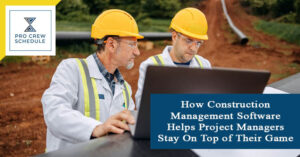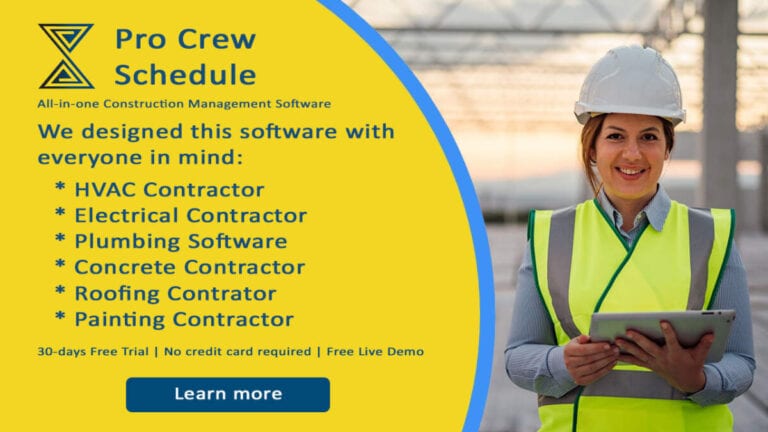In managing construction projects, the single most important skill a project manager should have is organization.
There are too many information, documents, and deadlines to keep stored in your head. And suppose you don’t organize these aspects. In that case, you’ll never follow through with your commitments, and the people under your responsibility won’t be able to keep their obligations.
You can’t be an effective project manager if you’re not organized, and this is where construction management software comes into play.
1. The Project Stakeholders
As the project manager, you’re the keystone that holds the whole project management team together. Due to this, it’s important that you have a plan of action and an approach to communicate that plan to your project team.
a. Project Owners
Establishing a good relationship with the project owners is very important. They fund the entire project and deserve the utmost attention and respect.
Owners are usually interested in high-level project information such as progress reports and budget status. But regardless of their personal interest, they deserve the most accurate and updated project information on demand.
Construction project management software gives owners a real-time dashboard to stay updated with everything from job site photos to detailed inventory status. Since the software is based on the cloud, owners can also access design drawings, contracts, specifications, and documents wherever they are. Everything they need is available and with just a few clicks of their fingers.
b. Subcontractors, Trade Contractors, and Suppliers
Subcontractors, trade contractors, and suppliers all have different needs at different phases throughout the project.
As the project manager, you must provide these technical stakeholders with quick and easy access to drawings, specifications, and contracts. Most importantly, they must be informed of their assigned tasks and the schedule for when they should be done.
A construction crew dispatch software ensures that stakeholders are always notified where they’re needed on the project and when, so you don’t have to spend so much time following up with them. This will make delegation a whole lot easier.
c. Construction Team Members
Many general contractors use self-performing teams to execute large portions of the project scope. Self-performing teams give the general contractor time since they have more control over the project’s schedule and overall outcome. However, your project superintendent and foreman still depend on you for management.
You want to give your crew members the tools to sequence their work properly for maximum efficiency and to keep the project running smoothly.
A construction project management software can ensure that everyone has what they need to stay on task and to complete it on time.
2. Project Documents
The documents begin to stack up in the very early phases of the project and continue accumulating throughout the construction lifecycle. Some of the documents in a construction project are the following:
- Project Initiation Documents (PID)
- Architectural drawings (and as-built plans)
- Product and material specifications
- Procurement documents
- Project Management Plan (PMP)
- Contracts
- Schedule of Values
- Submittals
- Request For Information (RFI)
- Change Orders
- Punch lists
You need a way to organize and keep these documents for quick reference. You also need the option to archive them for project closeout, commissioning, and final turnover to the owner.
A construction management software not only stores your files for easy reference but also brings these documents to life during the construction operation by allowing you to use them in a visually appealing approach. You’ll be able to keep as-built images, walkthrough videos, and other animations when needed.
3. Project Meetings
With so many stakeholders demanding your time and attention, you need a way to cut through the distractions and efficiently collaborate with your project team.
Safety meetings, daily walk-throughs, and progress meeting reports can be uploaded and documented in the app from anywhere you are so everyone can be aligned with the data.
- Agendas
- Plans
- Photos
- Punch lists
- Daily reports
- Safety action items
With everything available digitally, updates are automatically available for review, and that can ensure better quality control.
4. Project Workflows and Processes
As construction operations grow more complex, so does the need for flexible and agile systems to manage their workflows. To conquer this roadblock, many organizations are shifting to construction management software.
a. Employee Onboarding
With a workforce slowly aging and a shortage of younger talents, the need to keep and attract skilled professionals is more vital than ever.
Here’s how a construction recruiting and onboarding workflow system can help your team.
- A standardized newly hired request form enters the HR system and triggers an open position listing on the company’s portal.
- Scheduling for virtual interviews and automated follow-ups provides a smooth hiring process.
- Employee background check and drug testing requests are automatically started, sent for approval, and dispatched as needed.
- During the onboarding process, the new employee’s orientation, safety training, and PPE disbursements are also carefully tracked and documented.
Once hired, HR can manage ongoing payroll, training, and work assignments. Employee change of status notifications and benefit requests will run through the system, too.
b. Safety Reporting Workflow
Documenting daily ‘toolbox talks and safety walkthroughs is mandatory for most construction projects. Construction project management software simplifies the tracking, scheduling, and documentation of these important activities to keep your project safe.
- Mobile forms and job site safety offices make filing and submitting incident reports to meet OSHA requirements easy.
- Role-based safety walk-throughs and meetings can be assigned based on the construction crew dispatch software.
- And the internal construction management system keeps a running log of these events tied to the scheduled dates of each activity.
This means safety managers can review incident reports and plan meetings across the company’s entire project portfolio. Armed with these trends, insights and high-risk situations become easier to navigate and solve.
This approach prevents future construction accidents in similar situations for a safer job site.
c. RFI Submittal and Change Order Management
Without relevant, accurate, and timely information, the project stops from being operational.
However, sharing this information with multiple stakeholders can be difficult. Specialized workflows built for managing construction can solve this problem.
- Pre-built templates lessen submission errors and speed up every documentation process.
- Standard, pre-set workflows ensure accurate and timely information.
- Workflow customizations push photo markups, plan sheets, and supporting documents for more efficient decision-making.
- Automated notifications and alerts keep everyone informed and on task.
- The cloud-based workflow management system for quick document submissions.
- Get status updates anywhere and anytime, by mobile or desktop
RFIs, submittals, and change orders will be delivered promptly for smooth and no-delay turnaround times.
d. Quality Assurance and Quality Control
High-quality construction work depends on two things:
- An aligned understanding of the quality specifications and standards and
- Frequent quality checks and inspections.
Construction crew dispatch software solves both of these quality issues. With the right system in place, quality control, and assurance managers can now set expectations and follow up smoothly.
- Specification documents can be attached to job orders and work packages.
- Quality inspection templates provide data standardization for more accurate documentation and reporting.
- Role-based punch lists are assigned to specific team members and subcontractors.
- Standard inspection reports create re-work delegation, with due date and pre-scheduled to avoid delays.
- Daily reports and quality checklists encourage photo sharing, which confirms that the work accomplished meets established quality specifications and standards.
- The construction management software stores the inspection logs within the online database for easy retrieval and future reference as needed.
e. Project Closeout
Project closure is not just about closing contracts, submitting waivers, and releasing your suppliers and subcontractors.
Closeout is your company’s last opportunity to provide the project owner with an exceptional service experience up until the end.
Pre-built collaborative workflows ensure that all the set project objectives at the start of the project have been met. The system has been storing support documents throughout the project’s lifecycle, so you can be at peace that there are no loose ends left to complete.
Key Takeaway
Supercharge your operational efficiency and productivity with an integrated and all-in construction project management software.
Whether an engineer, architect, general contractor, or subcontractor–construction crew delegation software makes managing all your projects easier with real-time construction crew management, scheduling, resource allocation, dispatch, materials management, asset tracking, and more.
Be an organized construction project manager with Pro Crew Schedule.
Take our construction management software for a test run and see how your work can get simpler.
- Collaborate and manage various projects remotely.
- Make date-informed decisions based on data in store in the platform.
- Keep your team accountable with their delegate work while empowering them always to do their best work.
- Gain complete visibility into your inventory and productivity operations, large and small.
- Do your best work with a construction crew delegation software solution built for the construction industry.
Successful project managers stay on top of every workflow of their organization from day one through the project closeout.







